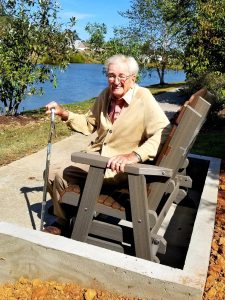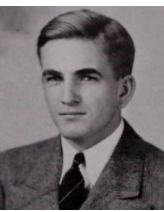
Very few live as long as Hubert “Hugh” Barnett has, but even fewer live a life as interesting.
Alive for two pandemics and two world wars — the latter of which he played an active role in through the Manhattan Project — Barnett holds the title of the University of Mississippi’s oldest living alumnus, according to the Ole Miss Alumni Association.
Ringing in his 107th birthday a few months ago, Barnett was born on Aug. 14, 1916, in Holly Springs, Miss. Barnett spent his childhood in Holly Springs, where his father was a rural physician, and he then attended high school in Greenwood, Miss., when his father went to work in the public health sector.
At age 14, Barnett rose to the rank of Eagle Scout in his local Boy Scout group by building a log cabin for his project. In 1931, Barnett traveled from Mississippi to Washington, D.C., with his fellow Scouts to meet President Herbert Hoover in the White House Rose Garden.
After graduating high school, Barnett attended Riverside Military Academy in Gainesville, Ga., for one year and then attended the University of Mississippi in pursuit of a degree in civil engineering.
As fond memories of his college experience resurface 84 years since graduating, Barnett recalls his experience at Ole Miss as a balance of work and play — or in his case, dancing.

“At Ole Miss, we would go to class five days a week in the mornings and the afternoons, and then on Friday or Saturday there would be a dance,” Barnett said. “And of course, at that time, we were co-ed, so there was lots of dancing.”
During Barnett’s time at UM, he excelled academically, becoming a member of the American Society of Civil Engineers and M.O.A.K.S., a senior honorary interfraternity organization.
Barnett also served as assistant editor of The Rebel, a humor magazine that captured the essence of Ole Miss student life in the late 1930s, and he was a member of the Ole Miss yearbook staff. Additionally, he was the campaign manager for the president of the Associated Student Body at UM.
As an engineering graduate, Barnett is the oldest alum of not only the university, but also the oldest engineering program in Mississippi, as UM School of Engineering is the oldest in the state.
As Barnett reflects on his undergraduate experience, memories of his time as a fraternity member flood back to him like it was yesterday.
“I was a member of Sigma Chi fraternity, and with our fraternity we would go to dances and social events,” Barnett said. “I enjoyed being a Sigma Chi.”
All three of Barnett’s siblings are University of Mississippi alumni, but Barnett is the only one living. Barnett’s sister, Nanny Louise Barnett, attended UM and the Mississippi State College for Women in Columbus. His older brother, Lee Aubrey, graduated from UM with a degree in engineering. Hubert’s younger brother, Robert, attended UM for his undergraduate education and went on to receive a medical degree from Tulane University. He became a lieutenant colonel in the U.S. Army in World War II and later established a medical practice in Jackson, Tenn.
Moving on from Ole Miss
After graduating from UM with a Bachelor of Science in Civil Engineering in 1939, Hugh Barnett took courses in business management from Purdue University.
From 1941 to 1944, Barnett worked in the Engineering Department at Remington Arms Company in Bridgeport, Conn. Barnett was granted top secret clearance by the Department of War to oversee the production and operation of small arms ammunition and classified weapons.
This position led him to becoming a staff engineer for the maintenance department’s superintendent in New York, planning the foundations for what would become the K-25 plant in Oak Ridge, Tenn.
As a maintenance supervisor at the K-25 plant in Oak Ridge, Barnett oversaw the utilization of gaseous diffusion to separate uranium-235 from uranium-238. Barnett was among a cohort of 300 officials who were aware of the top secret intentions of the K-25 plant.
“At the K-25 plant, I had 1,000 people under my supervision,” Barnett said. “We used gaseous diffusion where we separated the uranium isotope that was used in the bomb the U.S. dropped on Japan.”
The gaseous diffusion processes performed at the K-25 plant that Barnett supervised was one of the three isotope separation processes that provided uranium-235 for the weapon of mass destruction used on Hiroshima, Japan.
Even in wartime, Barnett continued to dance and spend time with friends alongside his wife by hosting dinner parties and a dance club in which he served as president.
What brought Barnett strength through the tense times of war was the camaraderie shared among the select cohort of workers with whom he car-pooled. Barnett spoke about his time at Oak Ridge in a 2012 interview conducted by Don Hunnicut for BBB Communications.
“We’re in our 20s or early 30s, and we were all buddies, friends. I didn’t consider it stressful, although I did end up in the hospital with an ulcer. We considered it fun as much as we, in other words, we wanted to get this damn thing done,” Barnett said. “We didn’t look at it as, ‘Well, I hate to go to work. I hate this.’ It was more of a challenge.”
Several days after Hiroshima and Nagasaki were bombed, President Harry Truman announced the unconditional surrender of Japanese armed forces on Aug. 14, 1945. The same day just so happened to be both Barnett’s 29th birthday and the day when he became a father, as his first child, Lee, was born — a moment that marked a turning point in Barnett’s life in many ways.
Barnett’s post-war life
Barnett remained with the K-25 plant until 1960, working all around the country for the planning department of maintenance and engineering.
“I was very successful in my career,” Barnett said.
In the BBB Communications interview, Barnett recounted how he met the love of his life, Shirley Smith Barnett.
“Shirley’s mother felt sorry for me, the poor little lonesome boy from Mississippi, so she phoned Shirley. Shirley was a receptionist at a machine tool plant,” Barnett said. “She phoned Shirley and said, ‘How would you like to meet a boy from Mississippi?’ Shirley pictured me with a straw hat with a toothpick in my mouth and she said, ‘Heavens, no!’”
“But that night, while Shirley’s mother went over and got me, brought me over there (and) introduced me to Shirley. We went down into the game room and played ping pong. She beat the stuffing out of me. I thought I could play ping pong until I played her,” Barnett said. “And then we put a record on, (and) we danced. Then, I asked her, ‘Could I come back tomorrow night?’ And she says, ‘Yes.’”
“So, I came back the next night. She let me beat her in ping pong, and it went on from that, and that was in June of ’41, and we were married the following May of ‘42.”
The pair remained devoted to each other in marriage for almost 60 years, having two sons, Larry and Lee. Shirley died in 2011.
Barnett’s son Lee would follow in his father’s footsteps by becoming a graduate of the University of Mississippi. Lee shared the impact his father’s legacy has had on him.
“It is truly an honor,” Lee Barnett said.

Barnett’s motto: Be happy
Over the years, Hugh Barnett has returned to UM for football games and tailgating in the Grove.
While living in Clarksville, Tenn., and Maryville, Tenn. Barnett has remained dedicated to helping his community. As a member of the Rotary Club for over 40 years, the civil servant has an estimated attendance of 2,200 Rotary meetings throughout the years. Barnett still drove himself to Rotary Club meetings until the age of 102.
Each passing year, the centenarian-plus-seven is honored with birthday parties, billboards and best wishes from his Tennessee community and beyond. At Barnett’s 103rd birthday party, Maryville Mayor Tom Taylor and Blount County Mayor Ed Mitchell proclaimed Wednesday, Aug. 14, 2019, “Hugh Barnett Day” as the community celebrated Barnett and his life.
In 2019, the Rotary Club of Maryville honored the Rotarian with a bench engraved with his name and lifelong mantra, “Be happy.”
Barnett resides at Asbury Place in Maryville and spends his time reading books as well as playing bridge, rook and other card games.
Barnett’s decorated legacy reflects that the secret to surpassing 100 — and nearing 110 — is living a life filled with joy, loved ones and lots of dancing.


























